Find Solitude in Theodore Roosevelt National Park
- Oops!Something went wrong.Please try again later.
This article originally appeared on National Park Trips
Theodore Roosevelt National Park in western North Dakota is known for amazing wildlife like bison and elk, 95 miles of hiking trails, horseback riding, water sports and for inspiring a love of nature in the nation's 26th president. President Theodore "Teddy" Roosevelt lived and ranched in the area in the 1880s. Later, as he served as president from 1901-1909, he placed more than 230 million acres of land under protection in the form of national parks, national monuments, national forests and reserves. The park was established in 1947.
Is Theodore Roosevelt National Park Worth It?
If you're looking for a national park with incredible wildlife, fewer people and a more remote feel, this is the national park to visit. Unlike other parks like Yellowstone that also offer incredible wildlife-viewing, Theodore Roosevelt National Park is far less developed. It also features striking grasslands and badlands that transform into a variety of colors, depending on the time of day. For history buffs, it offers a window into the life of President Theodore Roosevelt who ran a cattle business here for a short period of time in the late 1800s.
It doesn't have lodging or restaurants inside the park, so you can either make plans to camp at one of the two campgrounds in the park, get a backcountry permit to backpack in the park or stay in a neighboring town like Watford City or Medora. Its remote nature means that it get fewer visitors, which means it's easier to find solace and avoid any sort of traffic scenarios found in some of the nation's most popular parks. Pets and bikes are prohibited on all trails.
It's also known for its wild horses that were introduced to North America by the Spanish in the 1500s and to the Medora, N.D., area, where the park is located, in the mid-1800s. An important thing to know is Theodore Roosevelt National Park is comprised of three areas: South Unit, North Unit and Elkhorn Ranch Unit. Each area offers unique experiences, the South Unit being the most popular and the Elkhorn Ranch Unit being the most remote.
South Unit of Theodore Roosevelt National Park
The South Unit entrance is in Medora, North Dakota 27 miles east of the Montana state line. The Painted Canyon Visitor Center is located 7 miles east of Medora on I-94 at Exit 32.
You'll find bison here and the North Unit, but only in the South Unit will you find the famous Maltese Cross Cabin where President Roosevelt lived for a time. Roosevelt had the Maltese Cross Cabin built for him after he bought the Maltese Cross Ranch, also known as the Chimney Butte Ranch. It cost him $14,000 and included the cattle and the cattle brand. The cattle brand that came with the sale was of an eight-piece Maltese cross. Because of this, the ranch became informally known by locals as the Maltese Cross Ranch.
Maltese Cross Cabin in Theodore Roosevelt National Park
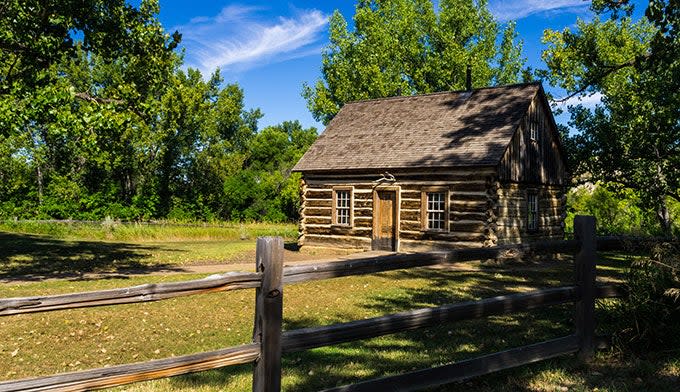
When it was built in 1883 with ponderosa pine logs, the Maltese Cross Cabin had a kitchen, a bedroom, a living room and a loft for ranch hands. After Roosevelt became president, the cabin traveled to the World's Fair in St. Louis in 1904 before circulating elsewhere, including Bismark, N.D. Thanks to Daughters of the American Revolution efforts, the cabin made it back to its original spot in 1959.
Today, the iconic cabin is located behind the South Unit Visitor Center. You can go inside and see a replica wooden writing desk (the park has the president's original desk in its collection for safe keeping) and even a trunk made of duck skin and wicker that belonged to the president. You'll see the initials "TR" on the trunk. If you want a sneak peek of it, take a virtual tour of the Maltese Cross Cabin.
Hikes in the South Unit of Theodore Roosevelt National Park
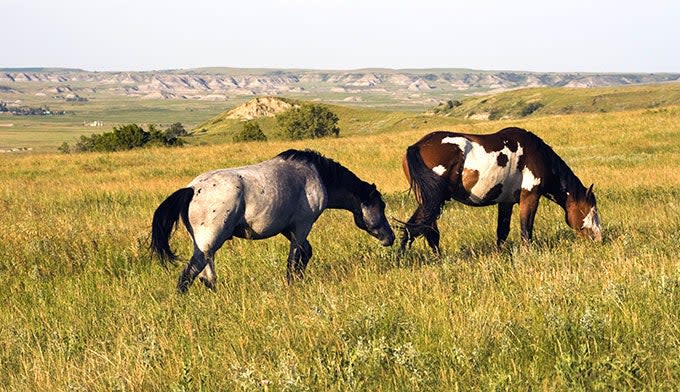
Beyond the Maltese Cross Cabin, there's much to explore in the South Unit. If you're taking a break outside your car or hiking, be sure to keep a minimum of 25 yards between you and bison or any other mammals in the park. What's unique about the South Unit is its the only place in the park where you'll see wild horses. For the best opportunity to see them, go on the Scenic Loop Drive or look for them from I-94.
For a short walk to see excellent sunset views, walk the .2-miles to Boicourt Overlook. You'll see the badlands transform into beautiful colors as the sun begins to set. For a hike that's just under a mile, head to the Painted Canyon Nature Trail. What's great about this hike is it takes you below the Painted Canyon rim to experience the canyon from inside rather than just above.
For a longer 14.2-mile roundtrip hike, go to the Maah Daah Hey Trail. The entire trail is 96 miles long and connects all three units of the park.
You can also explore an ancient petrified forest that's in the remote northwest corner of the South Unit. Along this 10.3-mile loop, you'll pass through badlands wilderness and ancient petrified forests. You'll be on several different trails for this loop, including North and South Petrified Forest trails as well as the Maah Daah Hey.
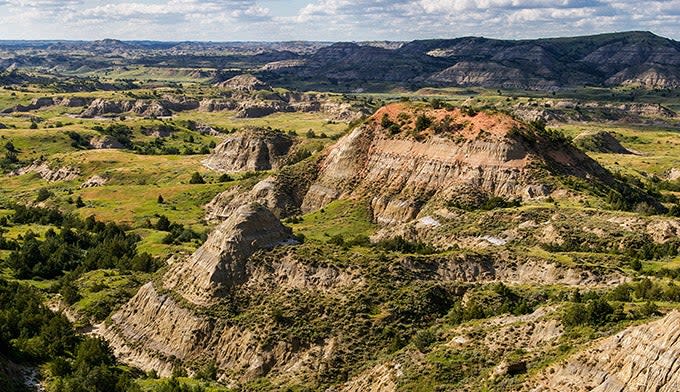
Cottonwood Campground in Theodore Roosevelt National Park
The South Unit has one campground, Cottonwood Campground, and it's more popular than the Juniper Campground in the North Unit. That means, make reservations online in advance or head there early in the day to get a camp spot. Cottonwood Campground fills to capacity every afternoon from mid-May through mid-September. It's about five miles from Medora inside the park. Half the sites can be reserved in advance at recreation.gov while the remaining sites are first-come, first-served. Most sites can accommodate tents and RVs. RVers should know there are no hookups at this campground.
A float trip down the Little Missouri River is an ideal way to experience the beauty and solitude of the North Dakota badlands. It takes about 5 days to canoe the 107.5 miles from the bridge at Medora to the Hwy. 85 bridge near the North Unit. Or do a short 3-mile trip from Sully Creek State Park to the Medora bridge. (The river water levels are variable. Please contact the park at 701-623-4730 ext 3417 for up-to-date information before launching on the river.)
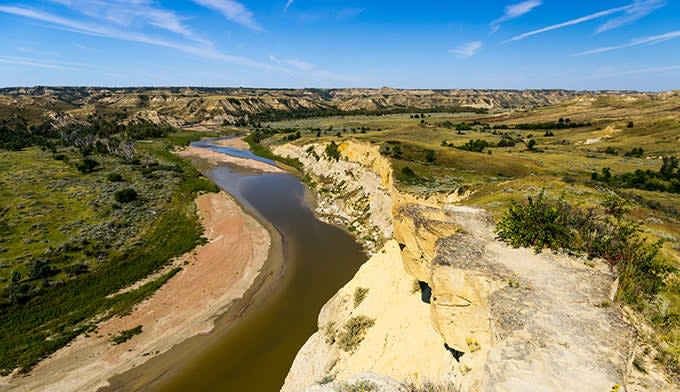
What to Do in Medora Near Theodore Roosevelt National Park
Located five miles from the park's South Unit, Medora offers several fun attractions. At the North Dakota Cowboy Hall of Fame, you can see interactive permanent and traveling exhibits on all things cowboy, along with Native American exhibits, at this 15,000-square-foot museum. It's located at 250 Main St., one block east of the Theodore Roosevelt National Park entrance and is closed in the winter.
You should also check out the Chateau de Mores State Historic Site. While at this stunning property, explore the 26-room home built in 1883 by the Marquis de Mores as a hunting lodge and summer home. He founded a meat-packing business, which collapsed in 1886. DeMores named the town after his wife whose first name was "Medora." This museum is only open end of May through early September.
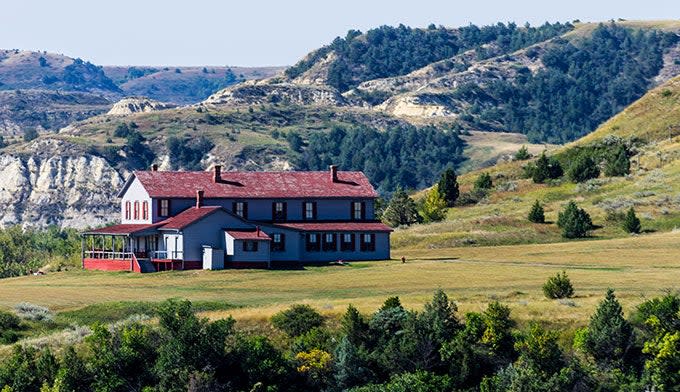
If you're a golfer, stop at the Bully Pulpit Golf Course.This 18-hole course has been ranked on a list of the country's 100 greatest public golf courses. Challenge your skills on holes 14,15 and 16, the infamous "Badlands Holes" that bring you through adventurous terrain.
North Unit of Theodore Roosevelt National Park
The North Unit entrance is a less-visited part of the park. It's along Hwy. 85, approximately 15 miles south of Watford City and 50 miles north of Belfield. The distance by road from Medora to the North Unit is approximately 70 miles. I-94 travelers can access Hwy. 85 at Exit 42 in Belfield.
You can spot bison in the North Unit, so keep your eyes open as you drive through here. Start at the visitor center, which is in a temporary building and sells souvenirs and books. It's a good place to get tips on what to see and do. There's a 17-minute film about the park that you can see here.
Interested in wildlife and seeing the park's badlands? The 14 Mile Scenic Drive is a popular way to spot wildlife. It's 28 miles round trip and takes you from the bottom of the badlands to the rim with scenic river overlooks along the way.
Hikes in the North Unit of Theodore Roosevelt National Park
To stretch your legs, the .7-mile Little Mo Trail takes you down by the river bottom. It's a paved trail and easy. To see a prairie dog town, go to the Caprock Coulee Trailhead and follow the Buckhorn Trail until you get to the prairie dog area. It's 1.5 miles and easy.
Prairie dogs are small mammals that are highly social, using a network of tunnels underground as their homes. A group of prairie dogs is called a coterie. Scientists have discovered prairie dogs share common sounds to communicate with one another about predators and others in the area. While prairie dogs are cute, keep your distance from them, do not go near their holes and never feed them. They are wild animals and can bite. They also can attract fleas that carry the bubonic plague, which can then be transmitted to humans. Lastly, their network of tunnels can attract all sorts of small animals, including predators like hawks, bull snakes and rattlesnakes.
Or go for a longer 4.3-mile hike on the Caprock Coulee trail that leaves from the same trailhead. Follow the trail as it climbs a grassy butte before descending. For a challenging 11.4-mile hike, take the Buckhorn Trail that will lead you through prairie dog towns, deep canyons and prairies.
There is one campground here called the Juniper Campground. It's located 5 miles from Hwy. 85. There's no cellphone reception here. There is potable water on a seasonal basis. The dumping station is seasonal as well. You'll find vault and flush toilets at the campground. The Juniper Campground rarely fills to capacity and is first-come, first-served. There is one group site here that must be reserved in advance.
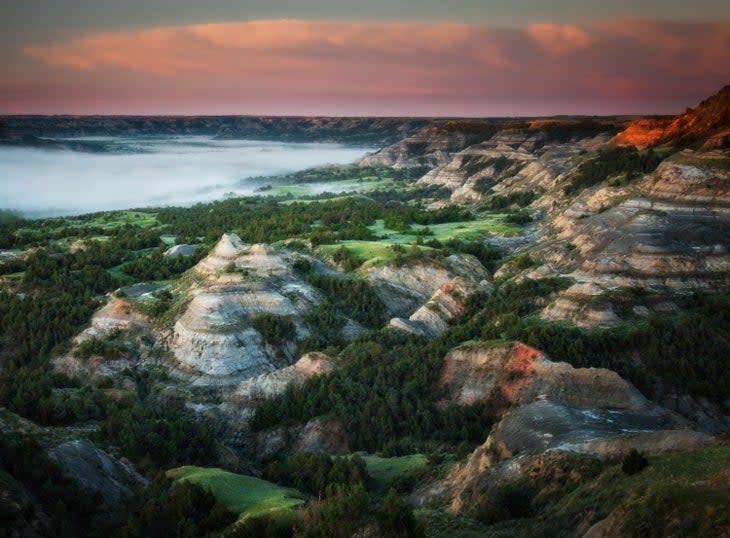
Elkhorn Ranch Unit of Theodore Roosevelt National Park
The Elkhorn Ranch Unit is located 35 miles north of Medora, and it's the most remote of the three park units. There are no facilities here, nor a visitor center.
For a short time, it's where President Theodore Roosevelt lived and ran a cattle business until 1890. He arrived in the area originally in 1887 to hunt for bison. But after two weeks, he had become enthralled with the area and purchased a ranch called the Maltese Cross Ranch where he ran cattle. Five months later, both his wife and mother died on the same day. Roosevelt sought solace in the area, hiring two men to build an eight-room cabin, barn, cattle shed, chicken coop and blacksmith shop for him at the second ranch he bought, Elkhorn Ranch. The Elkhorn Ranch cost him $400.
While the ranch house and buildings were pretty much stripped by 1901 after Roosevelt sold the ranch, you can still see the site where he lived. The stones that formed the cabin's foundation are still in place. You'll find the foundation after a .7 mile walk from the parking lot to the site on a grassy, mowed pathway. You'll find exhibits with Roosevelt's thoughts on them.
Getting to Roosevelt's Elkhorn Ranch
In Roosevelt's days, you could reach his ranch by horse. But even today, the ranch property is considered remote with no cellphone service for most of the drive out there and at the site. Access to the site is via gravel roads. Approaching the site from the east requires fording the Little Missouri River. In winter and during or after a rainfall, the road can get pretty bad, requiring four-wheel drive and/or high clearance vehicles. Ask a ranger at one of the park visitor centers for information on traveling to the Elkhorn Ranch Site before you attempt the journey.
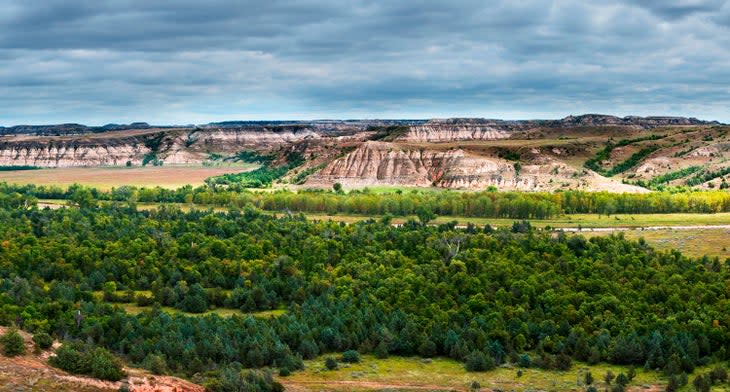
For More Information:
National Park Service
www.nps.gov/thro/
For exclusive access to all of our fitness, gear, adventure, and travel stories, plus discounts on trips, events, and gear, sign up for Outside+ today.

